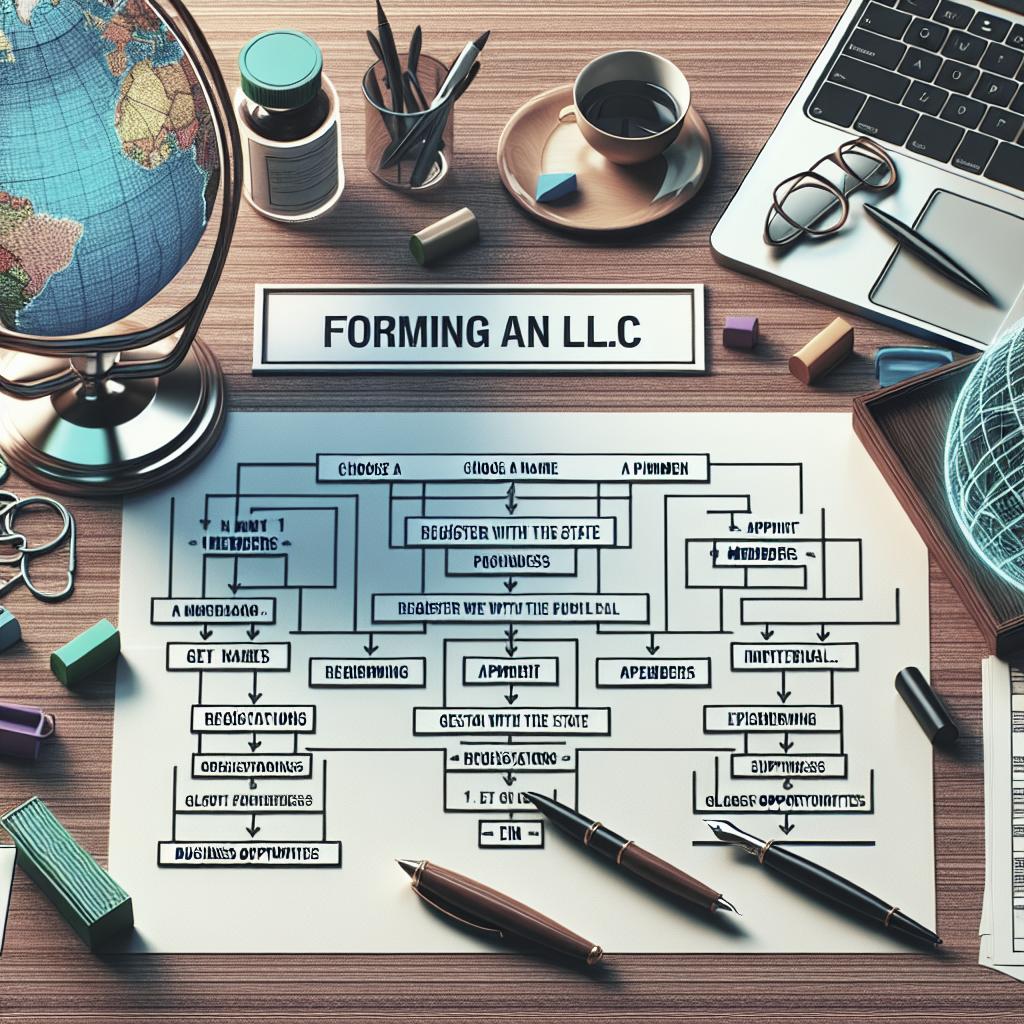“`html
Step-by-step Guide to Forming an LLC
Forming an LLC (Limited Liability Company) can be a pivotal step towards establishing a successful business. It’s crucial to understand whether an LLC is the right fit for your business goals, taxation preferences, and administrative capabilities. This comprehensive guide dives into the reasons to opt for an LLC, compares it with a sole proprietorship, outlines the key steps in forming an LLC, and highlights what to keep in mind for maintaining compliance. Additionally, it addresses common queries such as converting between structures and the necessity of a physical address. Each step is meticulously detailed to assist aspiring entrepreneurs in making informed decisions that can propel their businesses forward.
Is an LLC Right for You?
Starting a business requires weighing options and understanding various legal structures, among which an LLC is often considered beneficial due to its flexibility. LLCs combine aspects of corporations and partnerships, offering protection from personal liability while allowing operational flexibility. Before choosing this structure, consider your business goals and the level of risk you are willing to undertake.
LLCs are particularly attractive for small to medium-sized businesses that want legal protection without the complexity of a corporation. This structure also allows for flexible profit distribution among members, not tied to ownership percentage. However, forming an LLC involves more administrative work and financial expenses than a sole proprietorship.
What Is Better for Tax Purposes, a Sole Proprietorship or an LLC?
Tax implications are a significant factor when deciding between a sole proprietorship and an LLC. Generally, sole proprietorships offer simplicity in taxation as the business income is reported on the owner’s personal tax return. However, they do not provide the liability protection that an LLC does.
LLCs, on the other hand, offer multiple tax classification options. A single-member LLC can be taxed as a sole proprietorship, while a multi-member LLC can choose to be taxed as a partnership or elect corporate taxation. These options provide strategic tax planning opportunities, though they may require the guidance of a tax professional.
Can You Convert an LLC to a Sole Proprietorship?
Converting an LLC to a sole proprietorship involves dissolving the LLC and continuing the business in the owner’s name. This conversion may arise from the desire to simplify operations or reduce administrative burdens.
To convert, the LLC must complete a formal process, including closing out LLC accounts, resolving outstanding liabilities, and notifying state agencies. Each state has specific regulations and might require you to file Articles of Dissolution. It’s wise to consult legal advisors to ensure compliance and smooth transition.
Do You Need a Physical Address for an LLC?
Having a physical address for your LLC is generally required for registration purposes, albeit this doesn’t necessarily mean a commercial office space. The address may be a home or a virtual office that provides business services such as mail collection.
A physical address is crucial for receiving official correspondence, legal documents, and business notices. Some states prohibit using a P.O. Box as the primary business address, focusing on accountability and transparency.
Where Should You Form Your LLC?
Choosing the right state for forming your LLC involves evaluating business-friendly states like Delaware, Nevada, or your home state. Non-residents might favor states with low fees and favorable tax laws.
Forming an LLC in your home state can simplify operations, especially if you conduct most business locally. However, non-local operations may face additional fees and compliance regulations.
Step 1: Choose a Business Name
Your business name is a critical component of branding and identity. It must be unique, reflective of your business goals, and comply with state requirements. Conduct a thorough search in your state’s business registry to ensure that the name is available and not trademarked.
Consider securing the domain name for your prospective business name to establish an online presence. It’s important to strike a balance between a memorable name and one that project professionalism.
Step 2: Research State Requirements
Each state has distinct regulatory requirements and processes for LLC formation. Research the necessary legal documents, fees, and filing procedures specific to your chosen state. This ensures compliance and smooth application processing.
Some states have stricter regulations and higher annual fees; weigh these factors in your decision. Consulting with local business advisors or legal professionals can provide crucial insights tailored to your scenario.
Step 3: Prepare LLC Formation Documents
Preparing the Articles of Organization, or Certificate of Formation, is a mandatory step in forming your LLC. These documents outline key details including your LLC’s name, purpose, management structure, and registered agent.
Drafting operating agreements, though not always required by law, is highly recommended. This document specifies the management and operational aspects, including ownership percentages and member responsibilities, crucial during disputes.
Step 4: Appoint a Registered Agent
A registered agent acts as the official point of contact for your LLC to receive legal documents and government notices. This can be an individual or a business service specializing in handling such responsibilities.
The registered agent must have a valid physical address in the state of LLC formation. The selection of a reliable agent ensures that critical documents are received and addressed promptly.
Step 5: File LLC Formation Documents
Filing the LLC formation documents with the appropriate state agency formalizes your business. This step involves submitting the completed Articles of Organization and paying the requisite filing fees.
Ensure accuracy and completeness in your documents to avoid processing delays. Many states offer online filing options for expedited processing.
Step 6: Obtain an EIN and Business Licenses
An Employer Identification Number (EIN) from the IRS is essential for opening a business bank account, filing taxes, and hiring employees. Apply for an EIN through the IRS website for a streamlined process.
Depending on your business type and location, obtaining specific licenses and permits might be necessary. Ensure compliance with local, state, and federal regulations to avoid penalties.
Step 7: Maintain Compliance and Record-keeping
Staying compliant involves filing annual reports, paying state fees, and maintaining accurate records. Keep up with renewals and updates to your business information to remain in good standing.
Implementing diligent record-keeping supports financial transparency, legal protection, and strategic decision-making. Consider employing digital tools for seamless organization and compliance management.
Key Takeaways
Forming an LLC is an essential milestone in building a credible, legally-protected business. Careful consideration of tax implications, administrative responsibilities, and legal requirements are integral for a successful formation. Thorough research, proper planning, and regular compliance maintenance empower entrepreneurs to focus on growth and innovation.
The Bottom Line
| Decision Factors | Considerations | Steps |
|---|---|---|
| Choosing an LLC | Limited liability, Operational flexibility, Tax options | |
| Tax Structure | Single or multi-member tax registration, Compliance | |
| Compliance | Address, State-specific regulations | Research and Prepare Documents, Appoint Registered Agent |
| Filing | Accurate documents, State fees | File Formation Documents, Obtain EIN |
| Ongoing Management | Annual reports, Licensing | Maintain Compliance, Record-keeping |
“`


